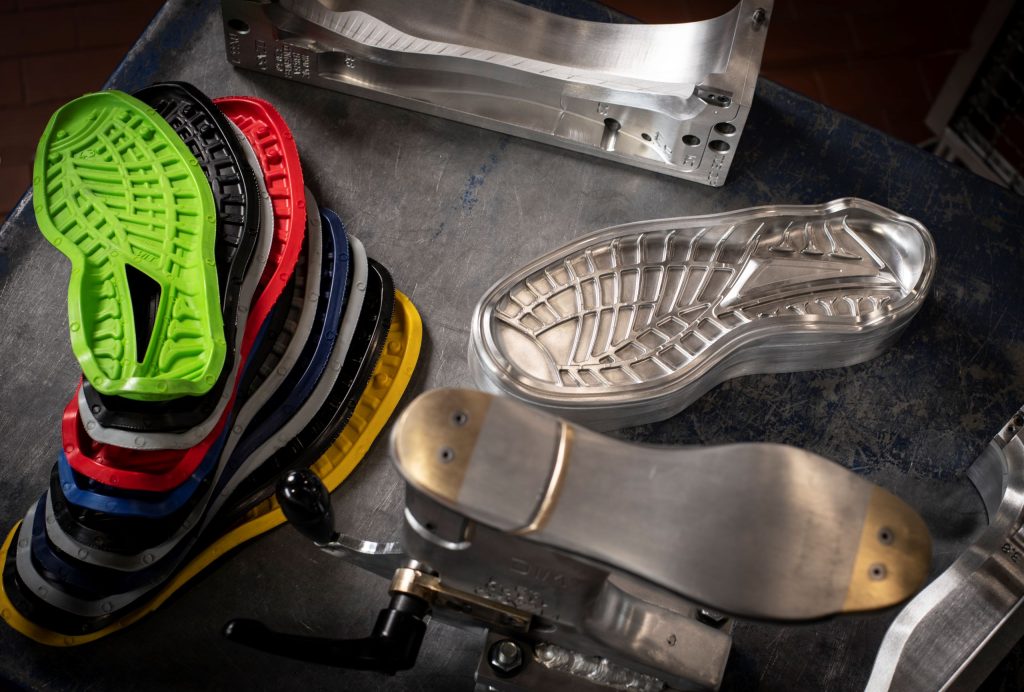STAMPI A REGOLA D’ARTE

Zago was founded in 1958 from the dream of Elio Zago. He began by producing moulds for glass bottles. In the 1970s, however, the major innovation of rubber soles appeared on the market. At that point, Mr. Zago’s vision became clear: to master the art of footwear mould making. Around 1990, he introduced the first version of the “double-ring” technology. To this day, it remains one of the most appreciated RUBBER/PU2 solutions among the company’s clients, particularly in the hiking footwear sector. Sharing the company’s story and future outlook is Giorgia Sposato, Zago’s PR & Marketing Manager.
What are the most important milestones in your history?
Among the key moments in our history, I would definitely mention 2013, the year that marked our first entry into PU boot mould construction. The initial injected boot moulds have since evolved into highly integrated solutions that expand shoe manufacturers’ options in terms of materials, number of densities, and toe-box choices. By 2018—our 60th anniversary—Zago had acquired a strong international customer base across many footwear sectors: safety, trekking, tactical, and occupational items. Today, Zago relies on advanced technological equipment to ensure smooth manufacturing processes. CNC (numerically controlled) production centres, five-axis machines, and robotic workstations have been successfully integrated with indispensable artisanal know-how to optimize time, efficiency, and minimize waste.
How would you describe your company as an entrepreneurial entity?
Zago’s origin as a family business is one of our core pillars. On one hand, it reflects our nature as a functional, organic company grounded in an efficient distribution of expertise. On the other hand, it exemplifies our commitment to our mission: enabling shoe manufacturers around the world to produce excellent footwear that is safe, comfortable, and durable. That is why we are always engaged in research and development and always ready to do our best—with our customers and partners.
Technological innovation is central to your operation: what are your latest technologies?
I would like to mention two particular products. First is the RUBBER/PU2 double-ring shoe sole mould (form for soles). Double-ring technology remains one of our most appreciated innovations. Aesthetically, it enables striking designs by allowing multi-coloured layers to be injected on the shoe’s side profile. Functionally, it combines different materials to optimize the foot’s rolling dynamics. By creating two distinct material layers, the double-ring technology improves shock absorption when the foot hits the ground. As previously mentioned, Zago first developed the double-ring solution in the 1990s. But today’s version of the double-ring is not what it used to be: originally, it comprised two separate shoe sole moulds (forms for soles) requiring machine adaptation. Today, it can be used directly on a Desma machine.
The second product is the BOOT shoe sole mould (form for soles). Zago began producing its first boot shoe sole moulds (forms for soles) in 2013, building on earlier experience with rubber boot shoe sole moulds (forms for soles) from the 1980s and 1990s. Since then, we have made significant investments in R&D, reflected in today’s BOOT product. This product aims for a high level of technical, technological, and material integration. The Zago boot shoe sole mould (form for soles) is designed and developed to meet customer production needs and is available in three variants depending on the type of production desired: PU/PU; RUBBER/PU; and PU/PU with TPU inserts. Its strength lies in production efficiency. Detailed cross-sectional and three-dimensional analysis—such as varying thicknesses and precise injection flows—optimizes material usage and ensures maximum product performance. All Zago shoe sole moulds (forms for soles), when properly maintained, have very long production lives—potentially indefinite—opposite to the concept of planned obsolescence.
Can you describe your mould range more specifically?
We specialize in injection shoe sole moulds (forms for soles) and sole shoe sole moulds (forms for soles). In injection moulding, we produce shoe sole moulds (forms for soles) for polyurethanes: single-, bi-, and tri-colour PU; TPU/PU; and RUBBER/PU; including boot shoe sole moulds (forms for soles). For soles, we produce compression shoe sole moulds (forms for soles) for rubber and TPU.
Which footwear industry segments do you serve?
We operate in several sectors, including Safety (Workplace), Trekking (Uneven Ground), Casual (Everyday Walk), Outdoor Sport, Postural (Healthy Walk), Defence (Tactical Situations), and Boot (Thermo-Grip Environments).
How was 2024 for you?
2024 was intense—but as with any intense year, also very stimulating. We never shy away from challenges; tackling them with full capability is part of our identity. The biggest highlight was our participation in the Desma House Fair 2024—a unique, engaging, and deeply stimulating environment, allowing us to meet motivated, competent, and passionate individuals.
What are your forecasts and plans for the coming year?
Engagement with the most demanding international clients enables us to envision a footwear industry still evolving. A distinctive element in moulding—especially in direct PU injection—will be the custom design experience. Dialogue, consultation, and flexibility will shape the future. The challenge lies in the continuous search for ever more innovative technologies. Material innovations will demand shoe sole moulds (forms for soles) capable of creating complex material configurations and combinations. Developing effective and reliable solutions will remain our central focus—in both R&D and production.